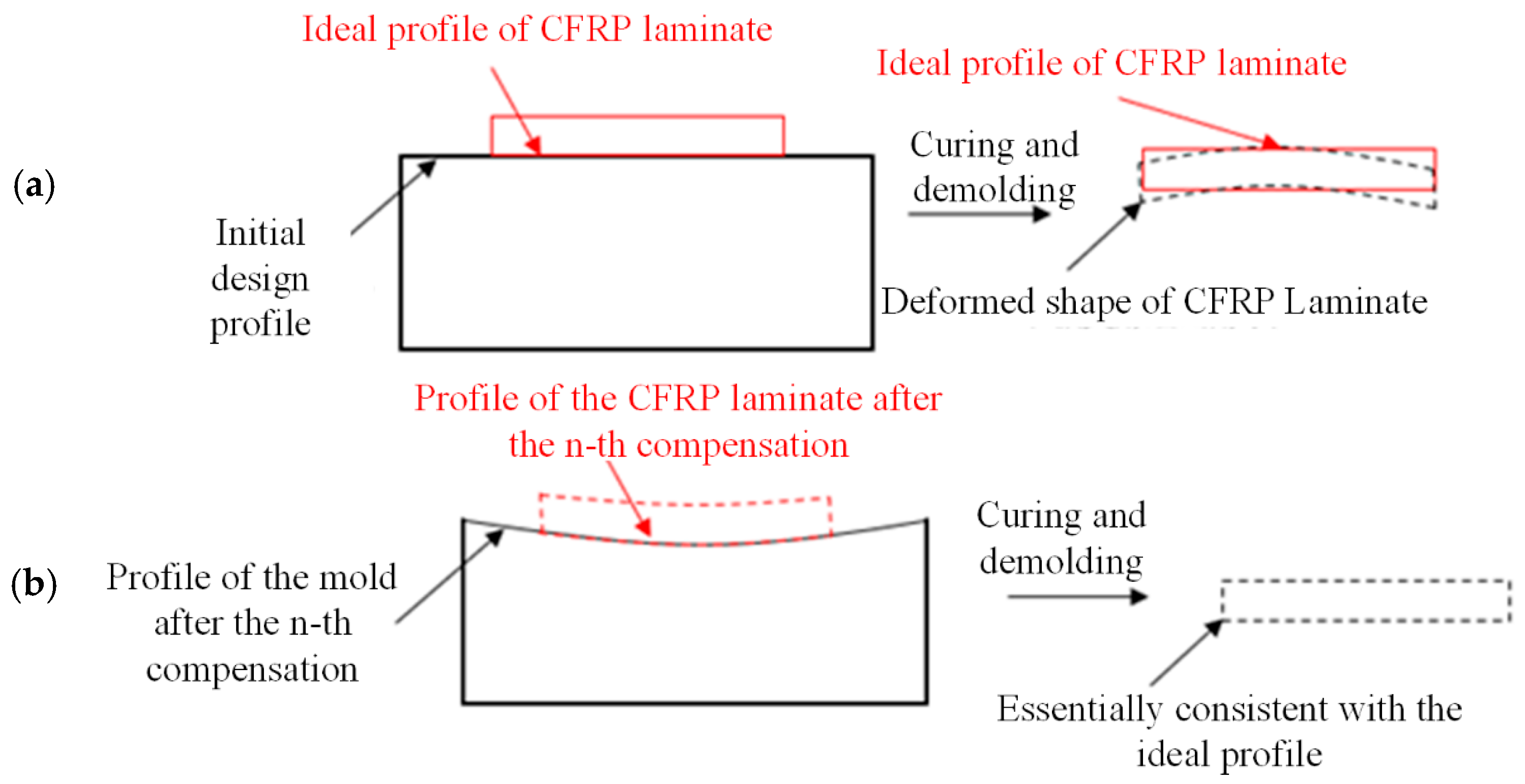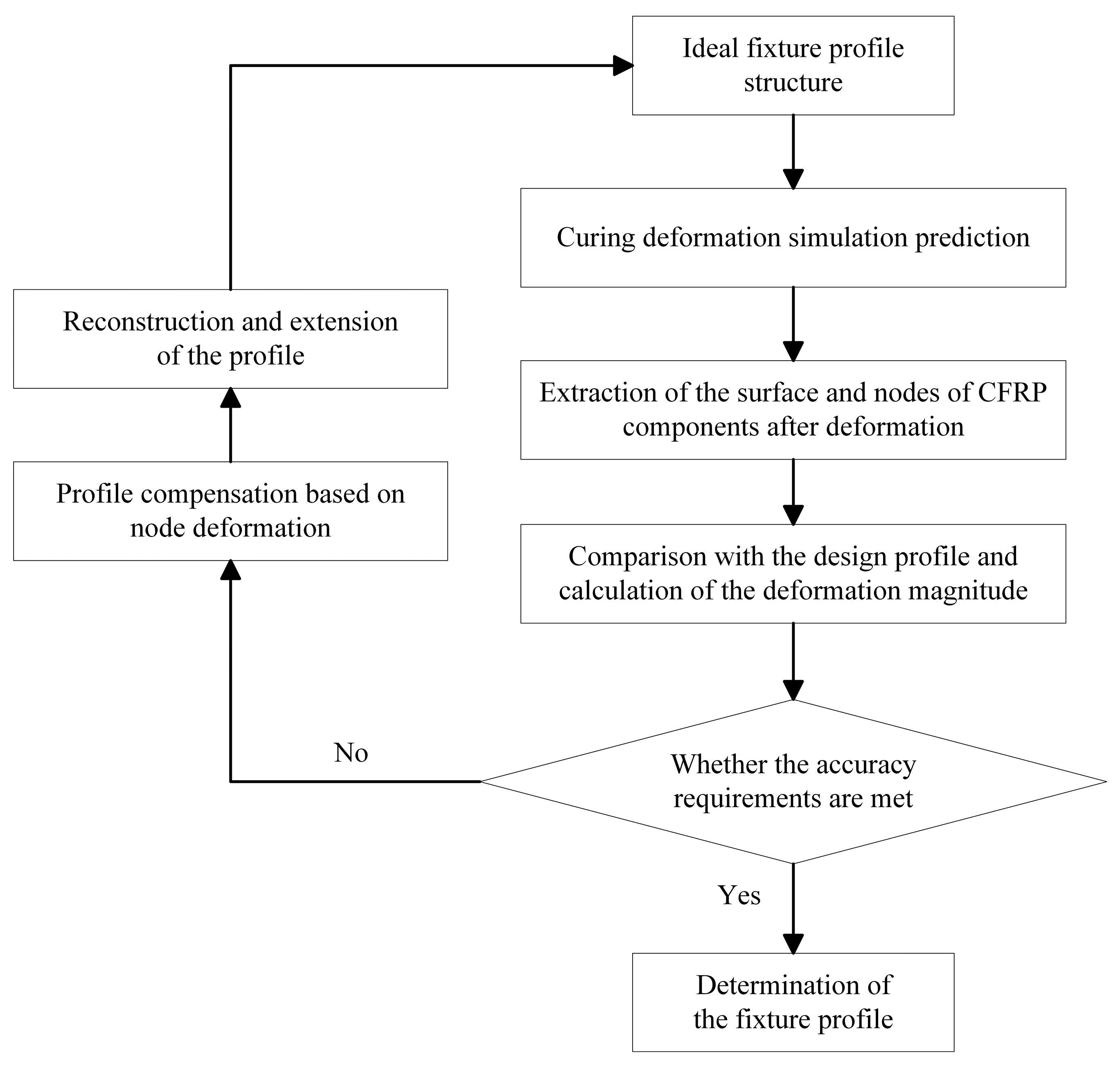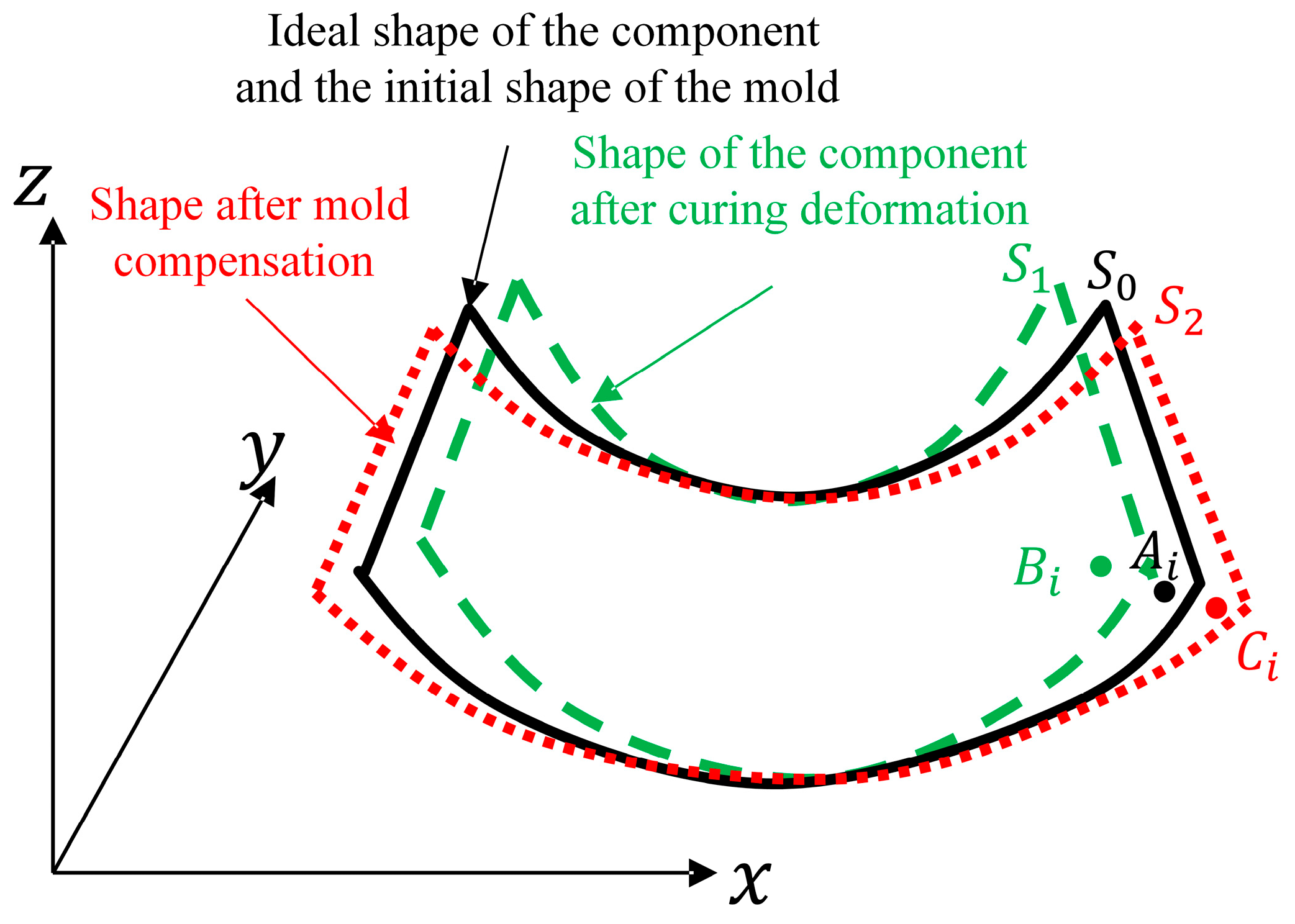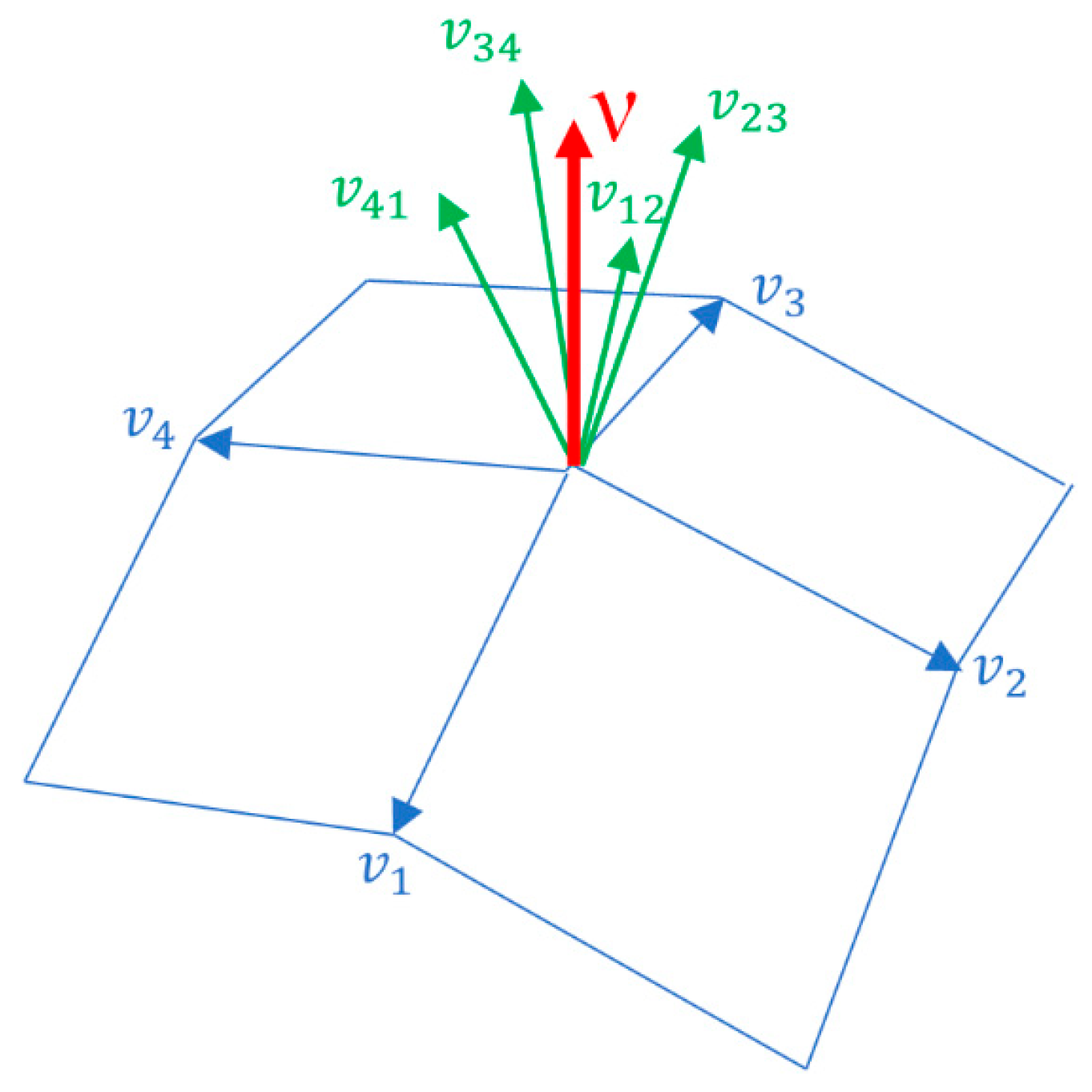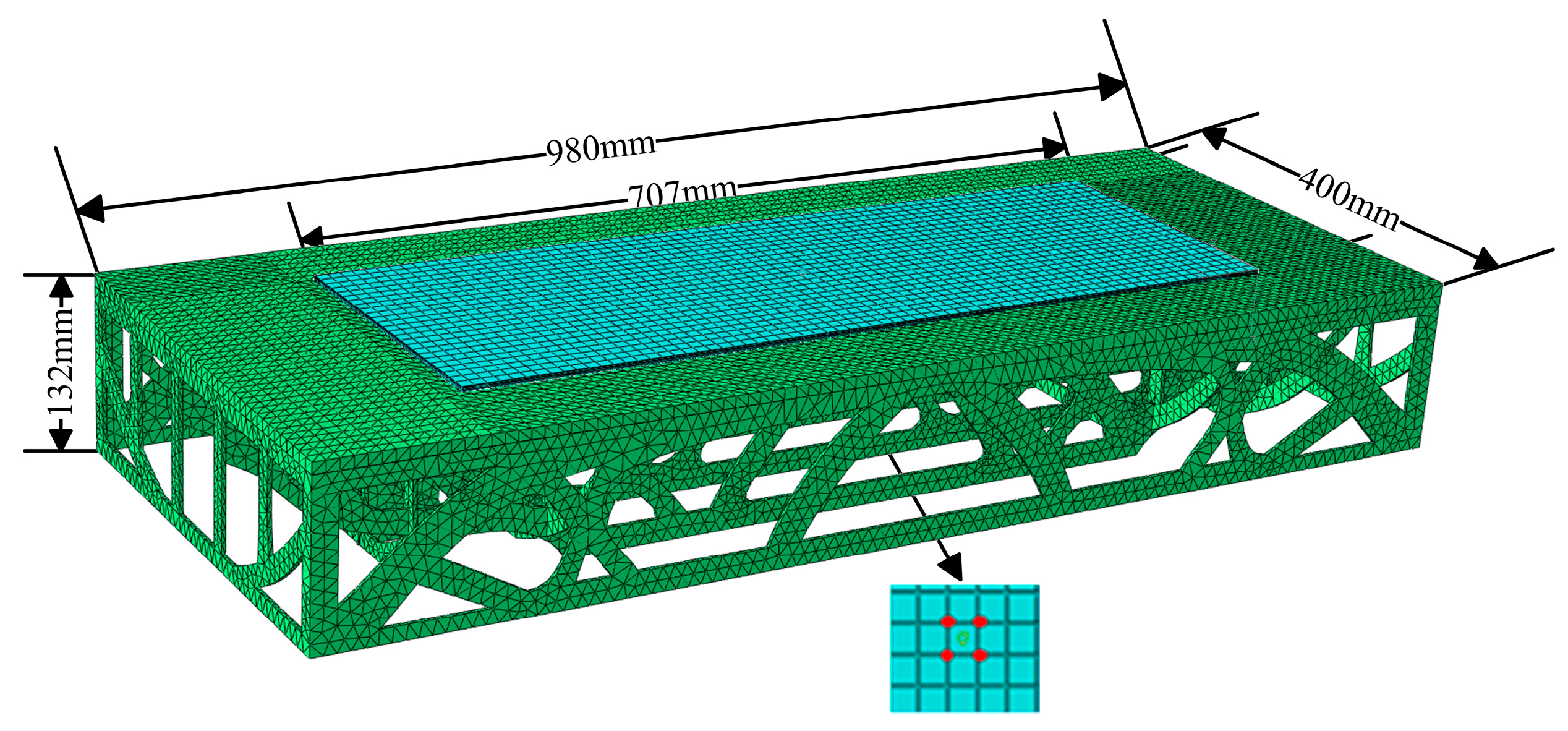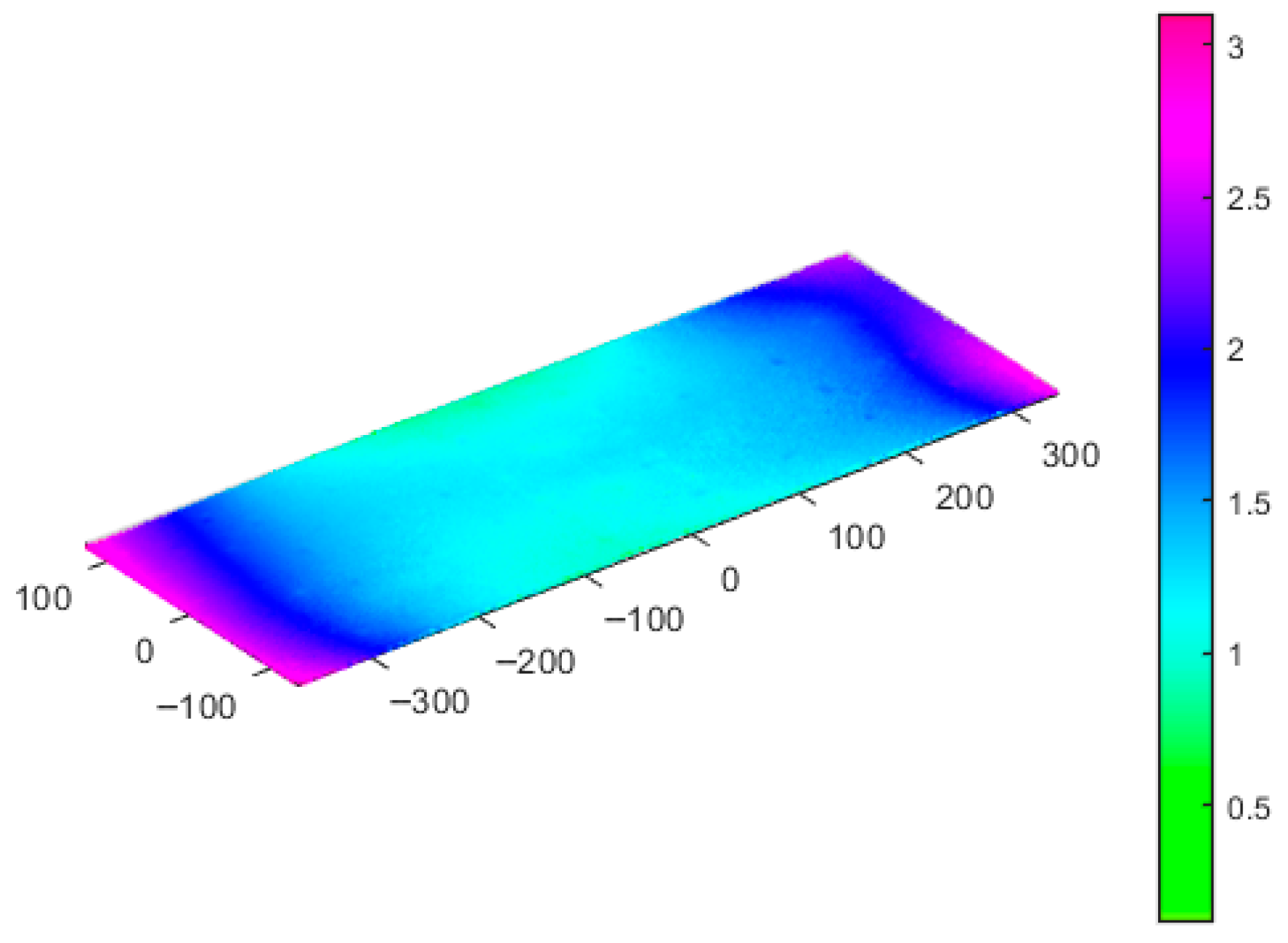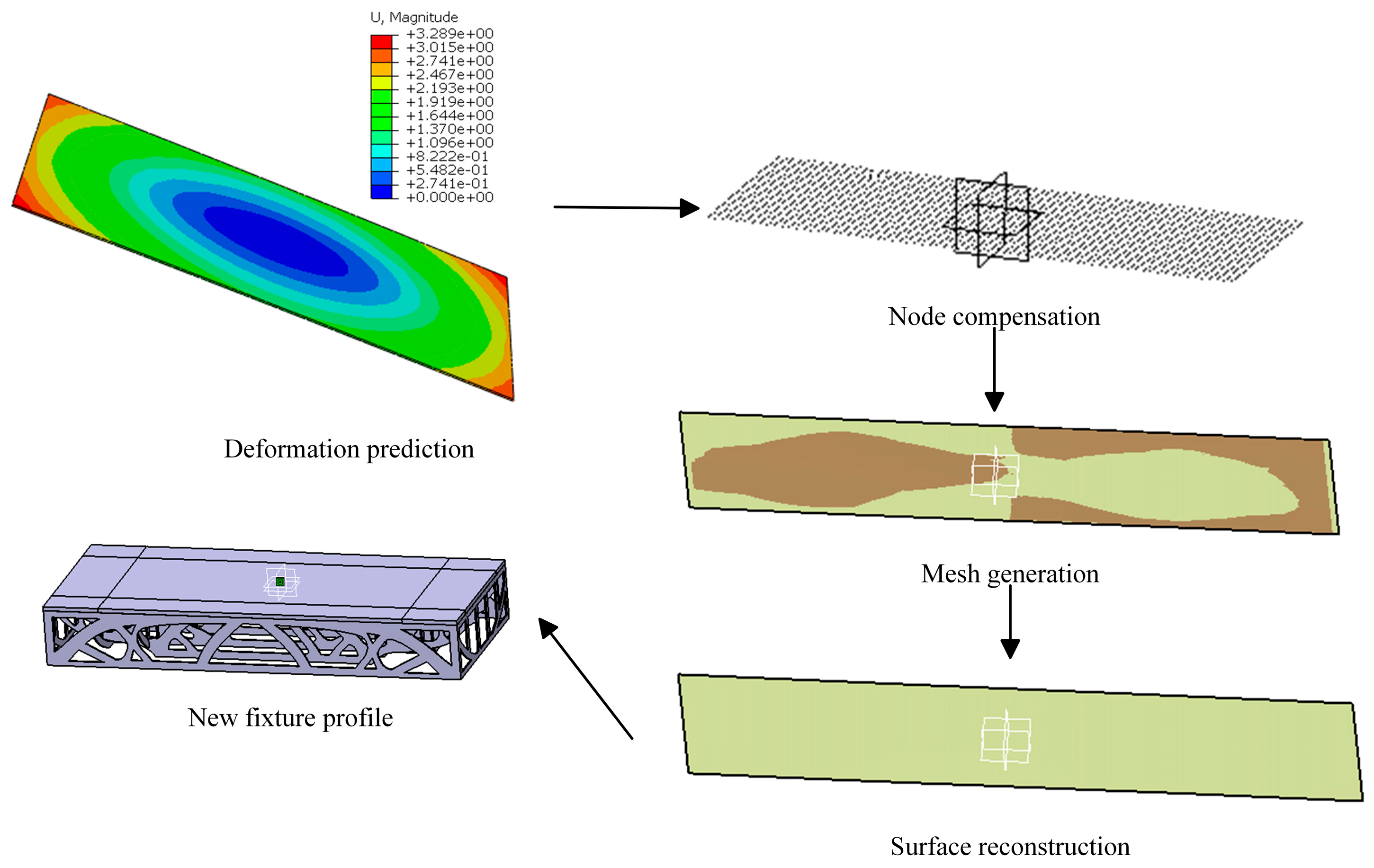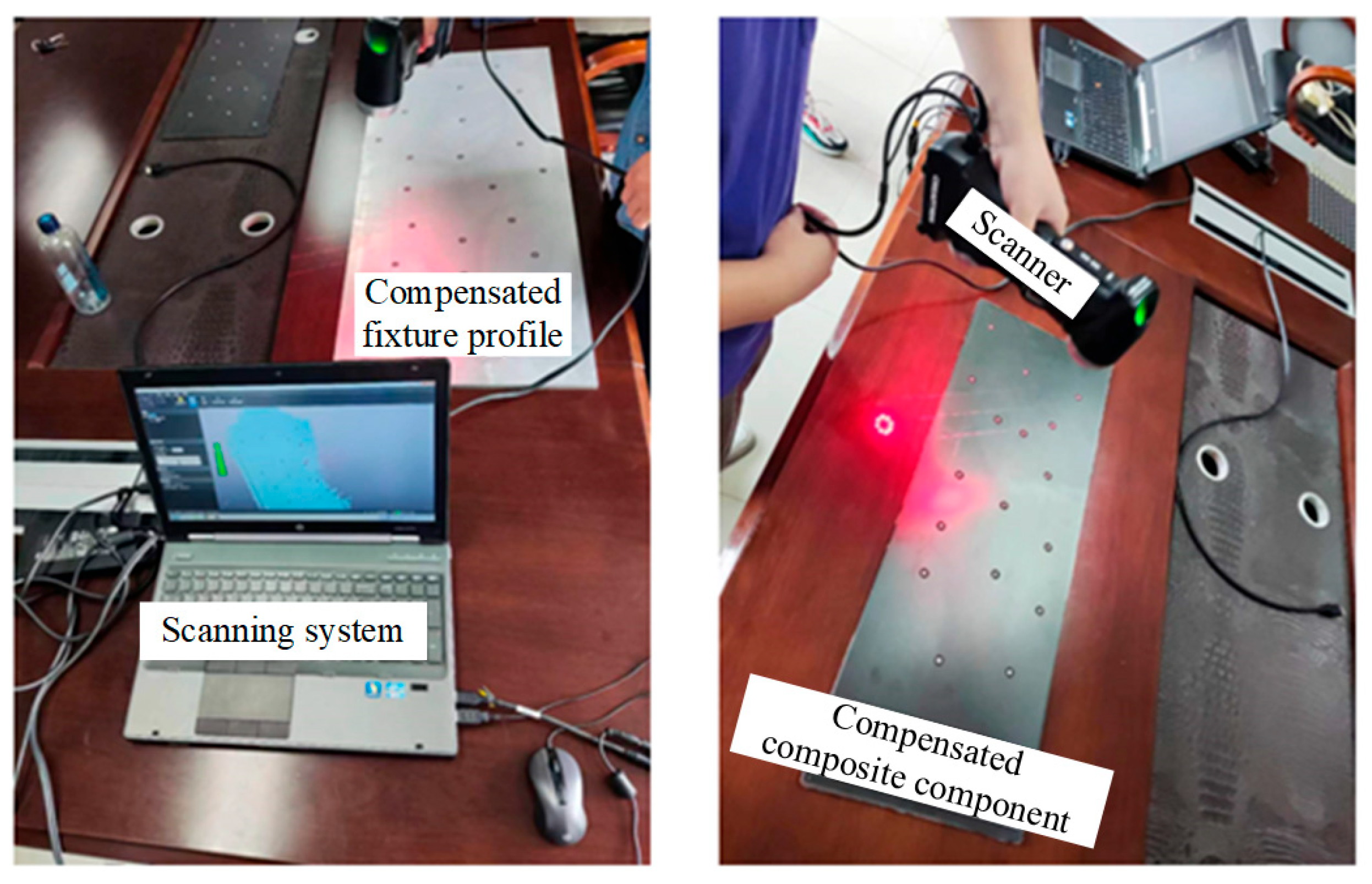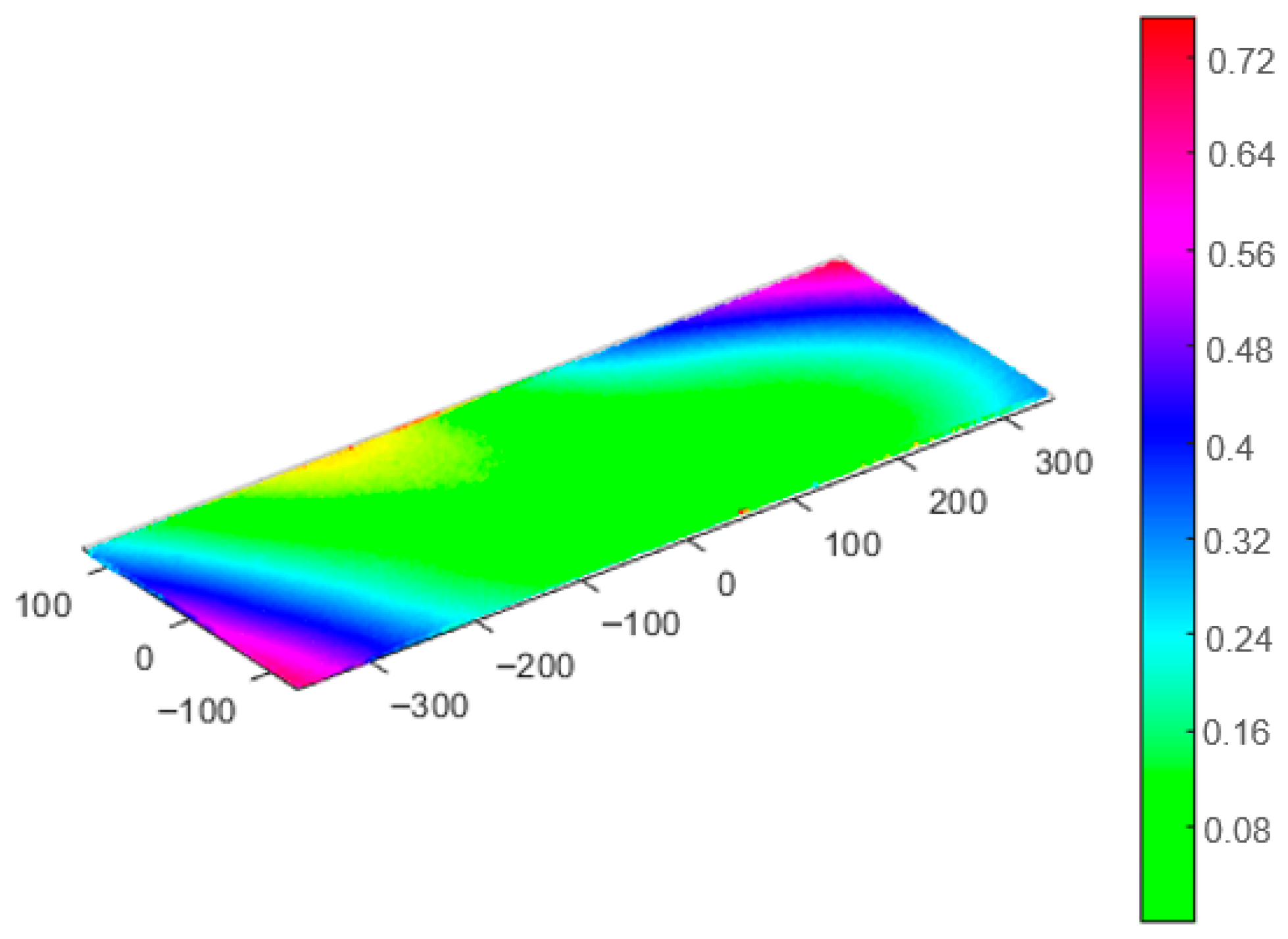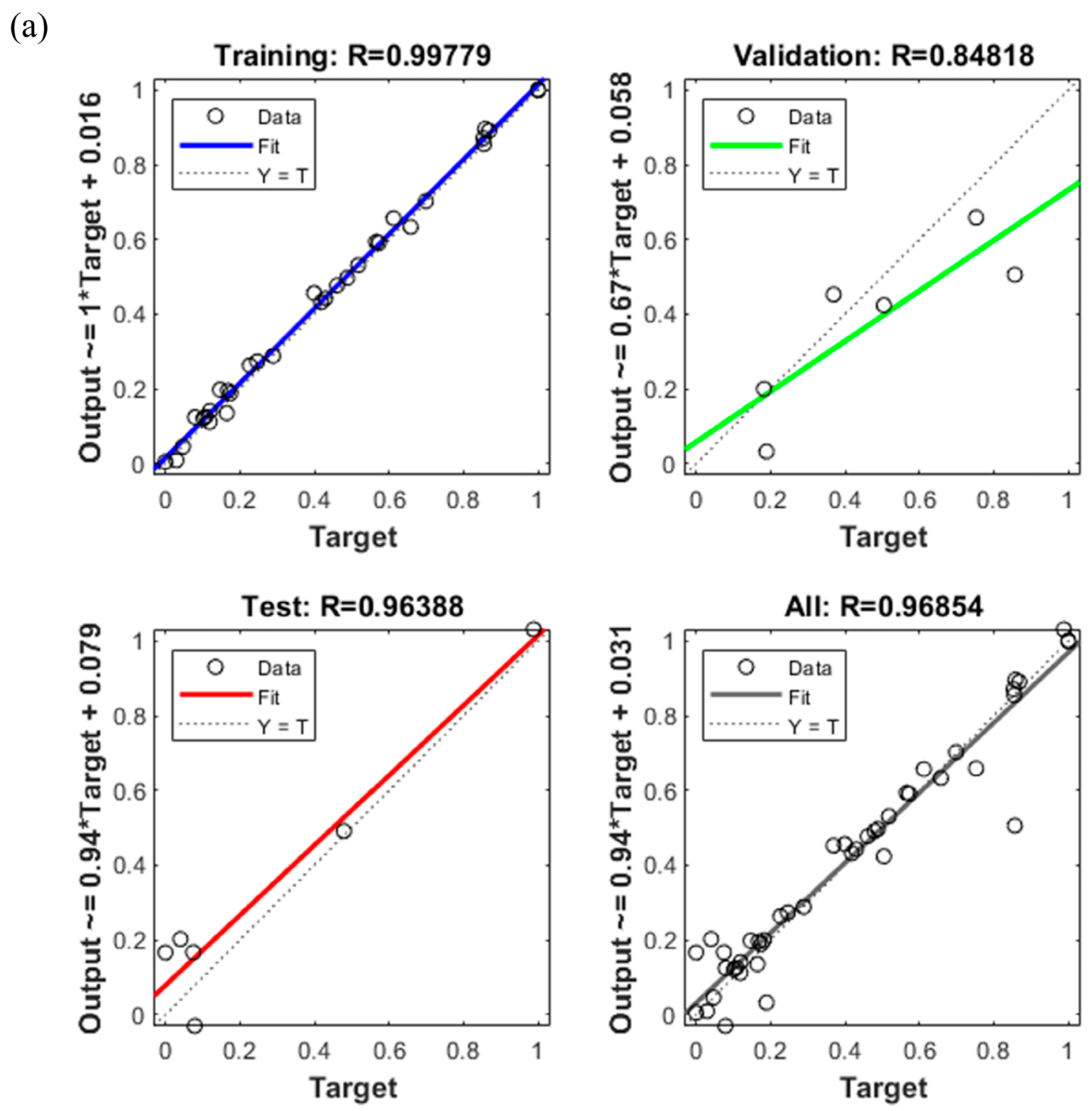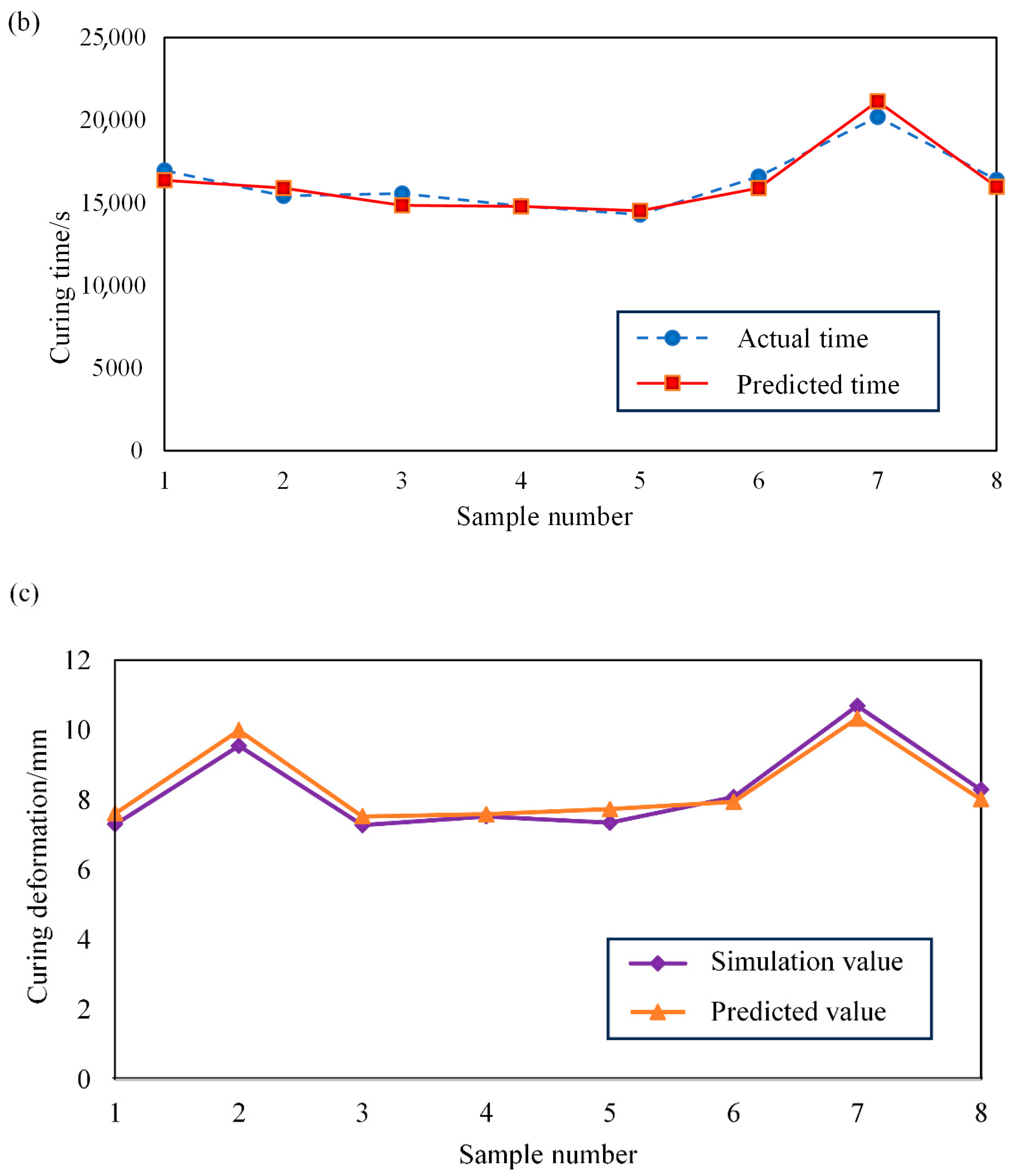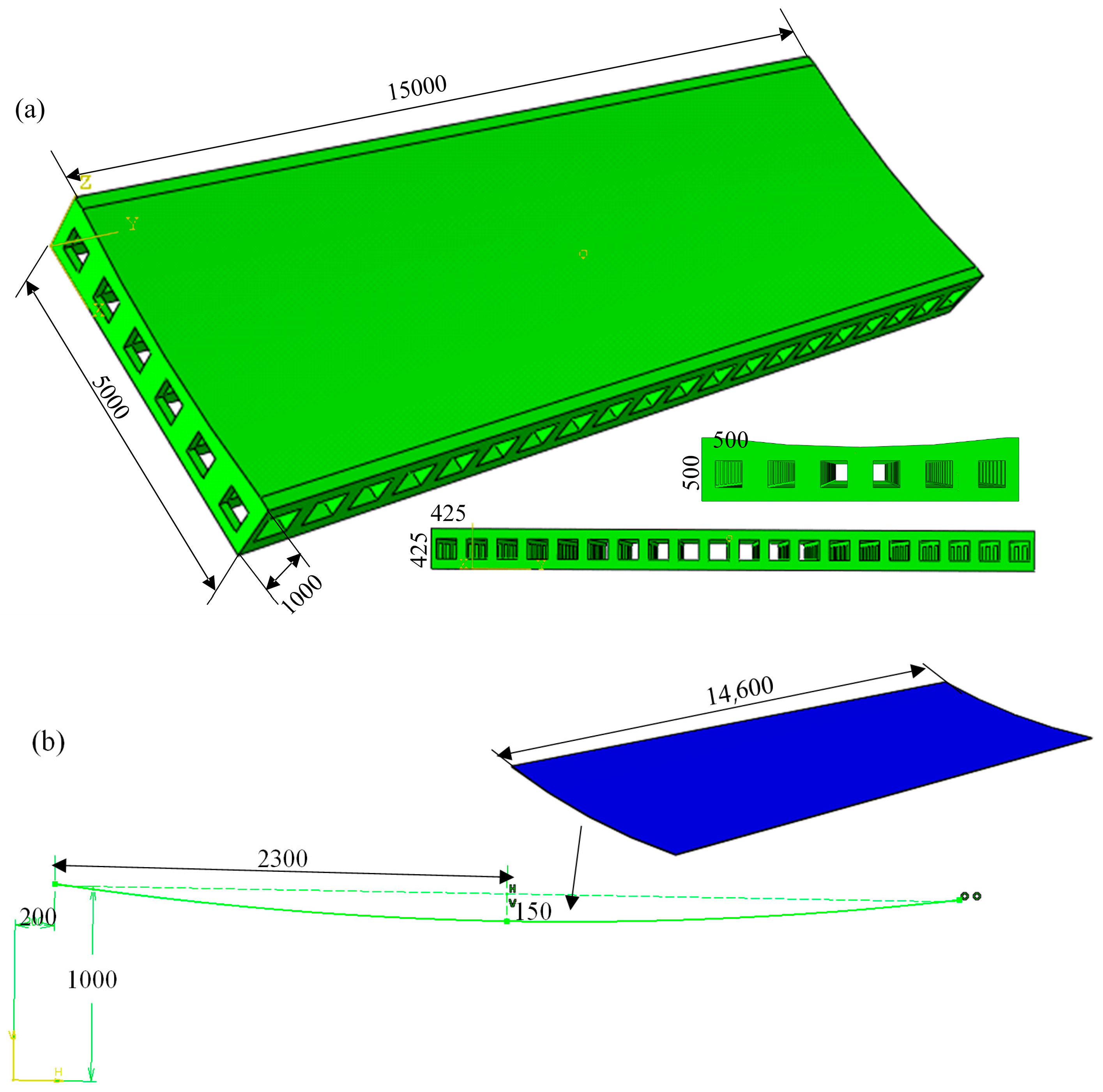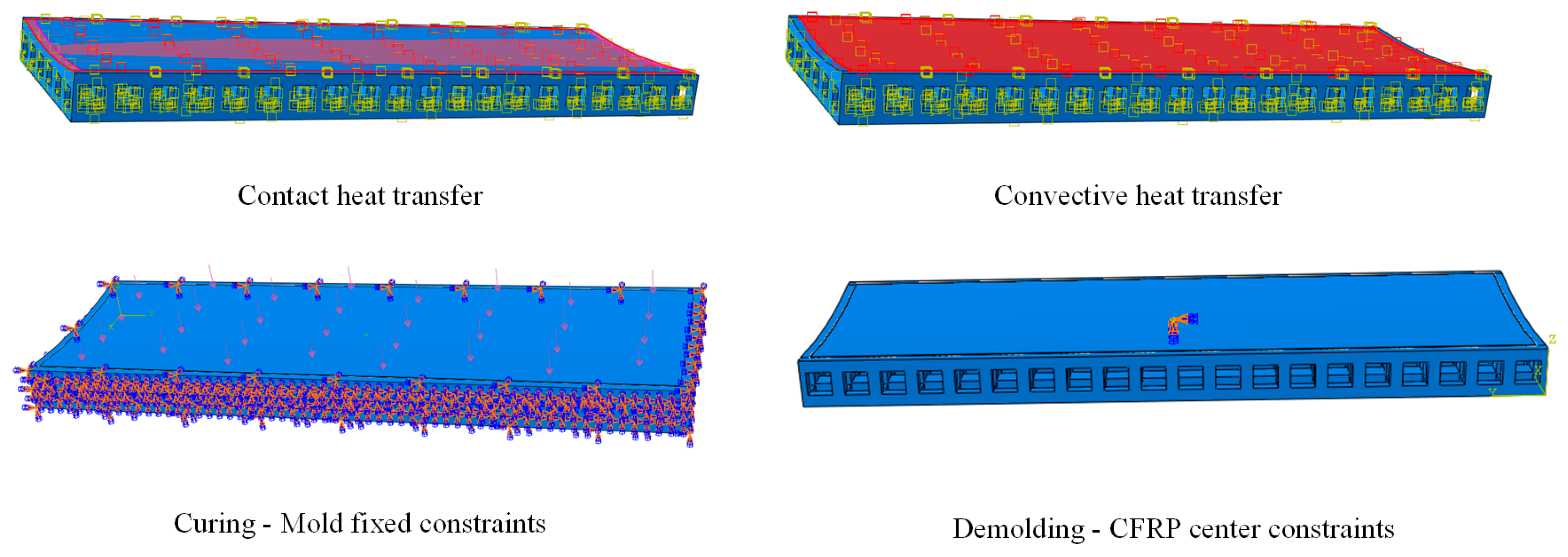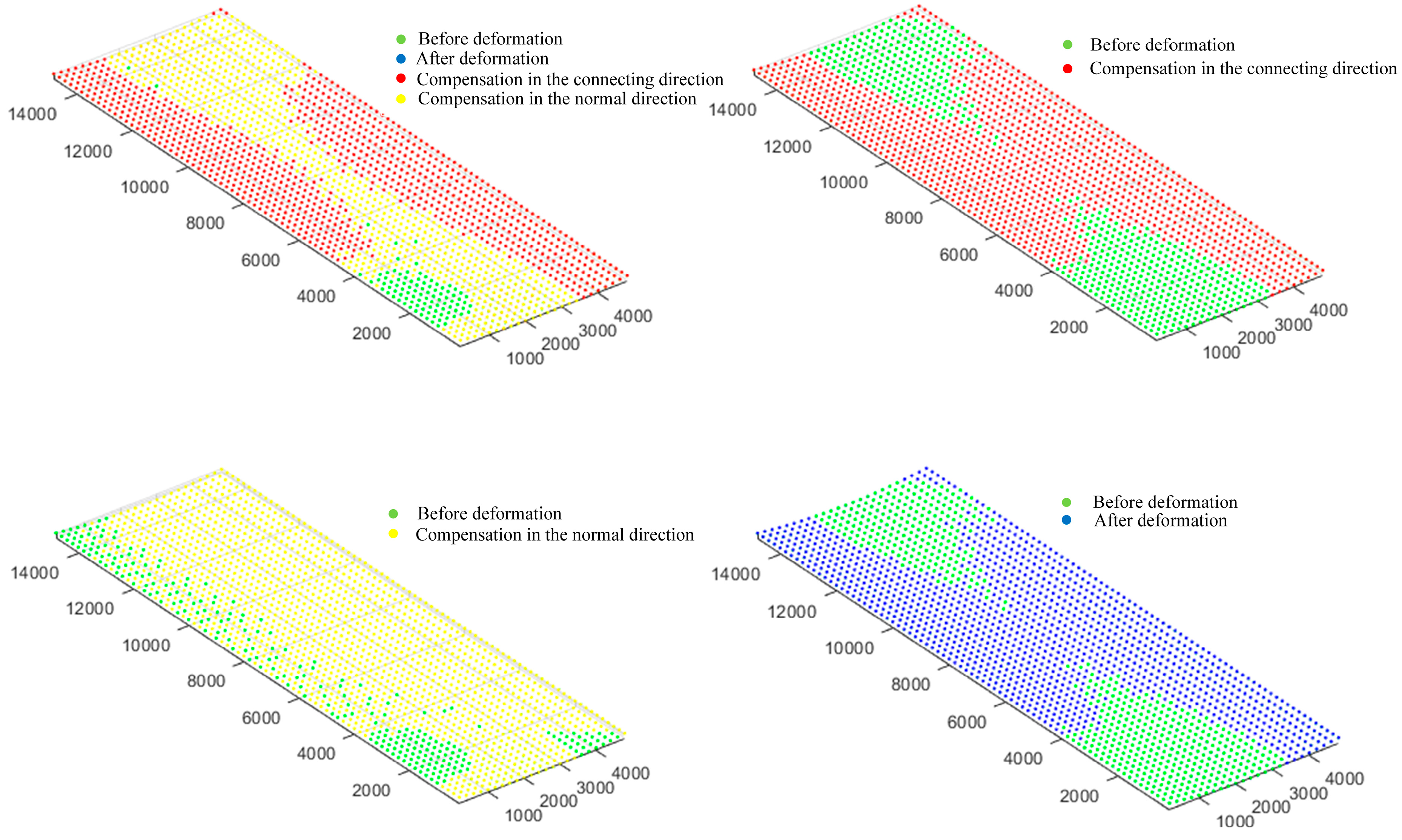1. Introduction
Carbon fiber-reinforced polymer (CFRP) composites are extensively used in the aerospace industry due to their high specific strength and stiffness, corrosion resistance, and lightweight characteristics [
1,
2,
3]. The large-sized, integrated design of main load-bearing CFRP structures has become an important development trend, aimed at meeting the requirements of high load capacity, long range, and high performance for next-generation aerospace vehicles. However, large-sized composite components exhibit uneven deformation after demolding, mainly due to thermal expansion differences between the fiber–resin interface and the CFRP, as well as between the CFRP and the mold [
4,
5]. These differences, combined with complex temperature variations on the large-sized mold surface, uneven internal stress distribution, and the release of residual stresses, contribute to deformation [
6,
7,
8,
9,
10]. In aerospace composites with varying curvatures and thicknesses, non-uniform structural deformation during assembly leads to internal damage or even component failure [
11,
12,
13]. Therefore, mold profile compensation is essential for improving the accuracy of large-sized CFRP composite components during the curing process.
Extensive research has focused on optimizing residual stress, process parameters, mold structure, and mold profile compensation. Rennick and Radford [
14], Radford and Diefendorf [
15], and Nelson and Cairns [
16] reported that the curing deformation of CFRP laminates, both in-plane and through-thickness, results from mismatched thermal expansion and chemical shrinkage of the constituent materials. Svanberg and Holmberg [
17] proposed a linear viscoelastic model accounting for thermal expansion, chemical shrinkage, and exothermic reactions during different stages of resin curing. The results indicated that the novel model improved computational efficiency and accuracy compared with conventional viscoelastic models. Prasatya et al. [
18] used thermo-viscoelastic modeling to calculate the curing deformation of composites and concluded that resin cure shrinkage contributed over 30% to residual stresses. Zhu et al. [
19] predicted residual stresses generated during curing and examined their effects on composite manufacturing accuracy. White and Hahn [
20,
21] developed a residual stress model to predict the curing process for composite laminates. Viscoelastic analysis revealed that chemical strains contributed less than 4% to residual stress in a typical cure cycle. Msallem et al. [
22] calculated residual stresses developed during curing using finite element simulation. The results underscore the importance of characterization accuracy and model selection. Feng et al. [
23] developed a multi-scale, non-orthogonal viscoelastic model to capture the constitutive behavior of preformed braided CFRP components during the curing process. Wang et al. [
24] proposed a physics-based numerical model to predict and compensate for deformation induced during machining of three-dimensional woven composites.
Process parameters of CFRP composites also have a significant impact on curing deformation. Sorrentino and Tersigni [
25] reported that for thick composite components, the degree of cure differs between the core and the surface, causing structural and geometric deviations. These issues mainly result from improper curing process design, underscoring the need for curing cycle design and optimization. Hui et al. [
26] used a neural network to replace the conventional curing kinetics model, identify kinetics parameters, and derive the curing process of CFRP composites. The neural network model substantially improved prediction accuracy for curing behavior. Zhang et al. [
27] derived the optimal compensation profile by establishing a coordinate model linking curing process parameters with mold profile compensation. Comparative results indicated that composite panel distortion was reduced by 86.2%.
In addition, curing deformation is effectively reduced by mold profile compensation. Li et al. [
28] established a simple mathematical model to predict the spring-in and warpage of T-shaped structures. The results revealed that cure shrinkage and thermal expansion were the primary drivers of deformation. Fernlund et al. [
29] investigated the curing process of C-shaped and L-shaped CFRP components and found that C-shaped components exhibited greater spring-in than L-shaped ones, which is attributed to the “geometric locking” effect of the part on the tooling. Furthermore, the differences in the thermal expansion coefficient between the mold and the CFRP critically influence curing-induced deformation. Wang et al. [
30] integrated a finite-volume numerical model with a GA to optimize mold support structures, achieving a 17.21% improvement in curing uniformity. Dong et al. [
31] proposed a compensation algorithm multiplying nodal deformation on the mold surface by a compensation factor, and the method effectively reduced curing deformation of CFRP components. Zein et al. [
32] introduced a method for adjusting the mold profile with a reduced spectral basis to eliminate curing deformation. Liu et al. [
33] developed a discrete curvature-based displacement adjustment method for mold profile compensation, which achieved dimensional accuracy for a composite skin in a single iteration, with a maximum surface deviation of 0.3 mm.
Most existing studies have addressed deformation prediction and compensation for small-sized CFRP components. However, methods such as profile compensation, mold structure optimization, and forming parameter optimization are inefficient and require numerous iterations for large-sized components. Traditional solutions rely on empirically determined curing parameters, followed by iterative adjustments and mold surface machining to control deformation. However, such iterative correction increases time and costs, hinders accurate mold surface design, restricts modifications to formed molds, and depends heavily on operator experience. In contrast, mold profile compensation based on node deformation remains one of the most effective and feasible approaches for controlling composite curing deformation. The purpose of this paper is to propose a curing deformation compensation method for large composite components in aerospace applications. The structure of this paper is as follows:
Section 2 presents the mold profile compensation method based on node deformation.
Section 3 presents the numerical analysis of CFRP curing deformation.
Section 4 discusses the optimization of curing process parameters.
Section 5 provides a compensation case for large-sized CFRP skin curing deformation. Finally,
Section 6 concludes the paper.
2. Research on Mold Profile Compensation Based on Node Deformation
2.1. Compensation Principle
The processes of the mold profile compensation method based on node deformation are as follows: first, coordinate data for all surface nodes in both the undeformed and deformed states are obtained; then, displacement variations between the two states are calculated; finally, compensation is executed using the mold profile compensation algorithm based on deformation magnitude and direction. The resulting profile is extended to the mold boundary to account for deformation caused by the CFRP curing process, ensuring that the deformed shape aligns with the ideal profile. The compensation principle is shown in
Figure 1, and the process is illustrated in
Figure 2.
2.2. Mold Profile Compensation Algorithm Based on Node Deformation
The inverse deformation compensation principle was applied using curing deformation prediction data to redesign the mold profile. The method involved post-processing numerical predictions for CFRP curing deformation. The coordinates of all nodes on the lower surface, along with their deformed displacements in the x, y, and z directions, were extracted for both the pre-deformation and post-deformation states. The mold was then compensated in both the connecting and normal directions to achieve the desired deformation control for the CFRP component.
- (1)
Compensation process in the connecting direction
As shown in
Figure 3,
represents the initial profile of the component and the mold, which is the ideal profile of the component. And the node coordinates on the ideal surface were denoted as
.
represents the profile of the component after curing deformation, with the node coordinates on the surface denoted as
.
represents the final profile of the compensated mold, and the node coordinates on the surface were denoted as
.
All nodes on the lower surface of the CFRP component in the finite element model were processed according to the compensation equation (where k is the compensation factor, taken as 1 for the convenience of this study). The set of all compensated nodes (where n is the total number of nodes) was fitted to a new surface, which was used as the new mold profile. The carbon fiber prepreg was laid on the mold with the new profile, and the cured CFRP component was checked to determine whether the condition (where is the dimensional accuracy of the part) was satisfied. The profile was considered as the final mold configuration when this condition was satisfied. In contrast, the optimization process of profile compensation for the mold was repeated until the accuracy of the cured CFRP component met the accuracy requirements.
- (2)
Compensation process in the normal direction
In normal direction compensation, the four mesh elements shared by each node were first identified, and the normal vectors of these elements were calculated. Next, the normal vector of each quadrilateral element was computed from three of its nodes, owing to the planar nature of the hexahedral mesh. Finally, these element vectors were aggregated to determine the normal direction for each node. The normal vectors of adjacent elements were summed and normalized to yield the nodal normal vector, as depicted in
Figure 4, where,
denote the four edges that form a node;
represents the normal vector of the plane formed by
;
represents the normal vector of the plane formed by
;
denotes the normal vector of the plane formed by
;
represents the normal vector of the plane formed by
; and
is the vector sum of
, the normal vector of the node.
The normal vector of each node is
, and the compensated coordinates
of each node are computed as follows:
Based on the above algorithm, a MATLAB™ (2022) script was developed to implement the compensation process. For the process of connecting direction compensation, only the deformation and compensation vector along this direction were calculated for each node, and the deformation was applied along the connection direction of the corresponding node. In contrast, for normal direction compensation, the normal vector of each node was required, and the deformation was subsequently applied along the normal direction to complete the compensation.
6. Conclusions
In this study, a normal direction compensation algorithm based on node deformation was proposed to establish an effective model for predicting and compensating for the deformation of large-sized CFRP components. Initially, the compensation process and the mold profile compensation algorithm based on node deformation were introduced. Subsequently, a finite element model was established to analyze the curing deformation of small-sized CFRP components and validated with a small-sized test piece. A maximum deformation of 3.252 mm was predicted by the numerical simulation, compared to an experimental measurement of 2.964 mm, yielding a deviation of 0.288 mm. The results validate the accuracy of the deformation prediction model. Next, a neural network model capturing the relationship between process parameters and curing deformation was established. A multi-objective optimization of the curing process parameters was conducted using the neural network model in combination with a genetic algorithm, with curing deformation and curing time both taken into consideration. Finally, a simulation model was developed to predict the curing deformation of 15 m CFRP components. The maximum deformation after optimization was reduced to 5.153 mm, representing a 41.67% reduction relative to the value prior to optimization. Further compensation showed that the maximum deformation in the normal direction after compensation was 0.9934 mm, demonstrating a significantly better compensation effect compared to the connection direction. Although the curing process was effectively simulated and deformation was controlled, certain limitations persisted, including limited simulation datasets and insufficient experimental validation for large-sized components. Most existing studies focus solely on curing deformation while neglecting deformation induced by demolding. Further research is needed to integrate demolding forces and methods into curing deformation analysis, thereby improving model accuracy for large CFRP components and enabling more precise deformation prediction.
